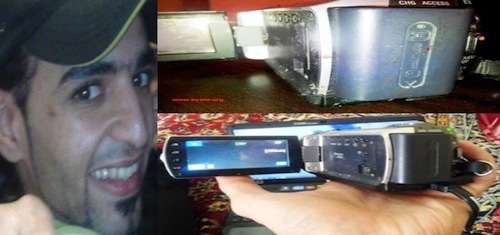Ľ News
The Blood of the Camera

2012-04-06 - 9:43 am
«Š ř—Ū— »«ŠŠŘ… «Šŕ—»Ū…
Bahrain Mirror (Exclusive): In Bahraini Revolution the camera is the most fearless. The photographers climb to be on the top of the buildings defying the armoured vehicles, for a cause they believe in. They overlook from the clouds, they get damaged or broken, and nonetheless they continue to operate.
Since 14 Feb 2011 until now, the camera is a major player in the Bahraini conflict arena. The photographers are more widespread and organized than the security forces. Almost there is a camera after each police battalion. Each corner is under the camera surveillance, under its hegemony, it rules the street more than the arms do.
Last Friday, 14 Feb Media Network and Islamic Action Society held a festival of “Media Victory”. Bahrainis have all the right to celebrate their media victory. This victory has been recognized by the regime, its loyalists and its GONGOs. That victory what made the regime form the fact-finding commission to investigate its crimes. That commission was the first in its bloody history.
The camera has been the means for that victory. Arts, by cameras, prevailed over bullets. Ahmed clung to his camera that captured thousands of pictures and video footages, since February 2011 until his death.
What Ahmed’s Camera Did?
In one of the purest sense of sacrifice, Ahmed Ismail went out with his camera without being held back by fear of death, injury or arrest. He was a journalist, artist, photographer, and he volunteered for a cause that he believed in, without waiting for any reward. Ismail captured, for history and the world, how the regime suppressed those peaceful people. Ahmed’s pictures and footages were uploaded for the entire world to see. The international news agencies might not have received them, neither the famous newspapers nor space channels, however, like hundreds of volunteers, he did not give up transmitting the truth.
The Place: Road 36 Eskan A’ali opposite to Salmabad
The Time: 15 March 2011 the day the martial law was declared and the start of the sweeping crackdown
Once the armed civilian cars showed up, Ismail’s camera got ready. It started to monitor a group of thugs accompanied by the security forces, taking control of a site in the road and shielding themselves in a corner, while a group of them stood on a roof of a building.
Ismail’s camera spotted them wreak havoc with some buildings, terrorizing the passers-by and making them return back their ways. The camera recorded their sabotage. Then the police vehicles came followed by the armoured vehicles and army machineries. They deployed in the road to spread terror and disrupt life. Crackdown started, in which all these forces took part, Ismail’s camera confronted them while the protesters’ voices shouting “We refuse humiliation”
The Time: 21 March 2012 one year later
Fierce madness that rampaged the villages and homes since March 2011, and March 2012 came but the madness had not stopped. Ismail’s camera captures a scene at the sectarian barrier that separates A’ali from Rifa’a. “Armed Civilian Militia” affiliated to the regime took hold of a checkpoint at night. The camera zooms in on one of them who was carrying a sword. Some of them covered their heads by the Arab head cover and were carrying swords and rifles. A car came to support them by more civilians, then a Ministry of Interior vehicle followed with more support. Then a car came from Rifa’a side that had the royal emblem and the King’s picture aiming his gun. They stood there for a while then left. Ismail’s camera continued to monitor them on the next day.
Ismail’s footage shows the effects of these militia, the bullets marks on a mosque in A’ali. Then pictures were shown of the live bullets that were fired at A’ali and Salmabad at different times and a young man injury by a bullet of the same type.
You still have things to say
“We knew your location and from where you film” That was the last post on a video uploaded to YouTube.
Ismail’s camera was monitoring the thugs for a year. It spotted accurately all their movements. It exposed the militia behaviour that the authorities exploited to distract the crowds away from the Pearl Roundabout and then to attack all who remained at it on 16 March 2011. Later, the authorities could not or did not want to contain those militias as they still need them.
IMCA Company provided media advice to the government for €80 to vie with the successful popular media and to assist the state media in its failure. However, they failed as well. The revolution has eclipsed the regime camera with all its lies and fabrications. As revenge is the regime nature, the regime wanted to drop the revolution camera through Ismail murder.
Finally, a bullet struck him by one of those he had used to film.
Ismail was murdered after a year he had spent roaming with his camera and documenting for history every crime that was committed by the regime. His camera fell down and stained with his blood while it was in operating mode. Still it has more to say that has not yet been revealed.
A collection of video footage Ahmed Ismail filmed in a detailed report by EA World News
Read More
- 2024-07-10Bahraini Authorities Summon Head of Sanabis Ma'tam, Threaten "Actions" Due to Mourners' Chants Against Israeli Occupation
- 2024-07-10Political Prisoner Mohammad Al-Raml's Family Say He's Vomiting Blood Due to Poor Conditions, Fear for His Life
- 2024-07-09Ali Al-Majed Arrested After His Return to Bahrain
- 2024-07-08Yusuf Al-Muhafdha: Convicted Returnees to Bahrain Have the Right to a Lawyer, Retrial, and Legal Guarantees
- 2024-07-08Reciter Mahdi Sahwan: Head of Manama Police Informed Me of Ban on Reciters Traveling to Commemorate Ashura